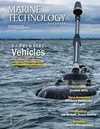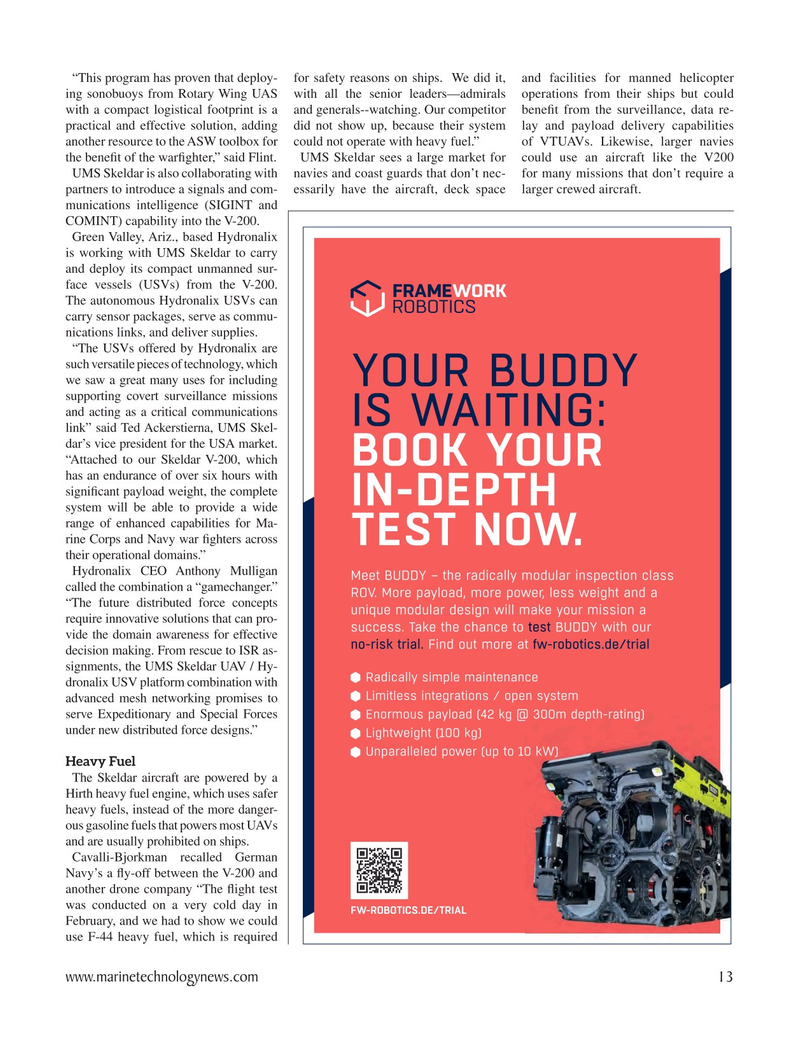
Page 13: of Marine Technology Magazine (January 2024)
Read this page in Pdf, Flash or Html5 edition of January 2024 Marine Technology Magazine
“This program has proven that deploy- for safety reasons on ships. We did it, and facilities for manned helicopter ing sonobuoys from Rotary Wing UAS with all the senior leaders—admirals operations from their ships but could with a compact logistical footprint is a and generals--watching. Our competitor bene? t from the surveillance, data re- practical and effective solution, adding did not show up, because their system lay and payload delivery capabilities another resource to the ASW toolbox for could not operate with heavy fuel.” of VTUAVs. Likewise, larger navies the bene? t of the war? ghter,” said Flint. UMS Skeldar sees a large market for could use an aircraft like the V200
UMS Skeldar is also collaborating with navies and coast guards that don’t nec- for many missions that don’t require a partners to introduce a signals and com- essarily have the aircraft, deck space larger crewed aircraft.
munications intelligence (SIGINT and
COMINT) capability into the V-200.
Green Valley, Ariz., based Hydronalix is working with UMS Skeldar to carry and deploy its compact unmanned sur- face vessels (USVs) from the V-200.
The autonomous Hydronalix USVs can carry sensor packages, serve as commu- nications links, and deliver supplies.
“The USVs offered by Hydronalix are such versatile pieces of technology, which we saw a great many uses for including
YOUR BUDDY supporting covert surveillance missions and acting as a critical communications
IS WAITING: link” said Ted Ackerstierna, UMS Skel- dar’s vice president for the USA market. “Attached to our Skeldar V-200, which
BOOK YOUR has an endurance of over six hours with signi? cant payload weight, the complete
IN-DEPTH system will be able to provide a wide range of enhanced capabilities for Ma- rine Corps and Navy war ? ghters across
TEST NOW.
their operational domains.”
Hydronalix CEO Anthony Mulligan
Meet BUDDY – the radically modular inspection class called the combination a “gamechanger.”
ROV. More payload, more power, less weight and a “The future distributed force concepts unique modular design will make your mission a require innovative solutions that can pro- success. Take the chance to test BUDDY with our vide the domain awareness for effective no-risk trial. Find out more at fw-robotics.de/trial decision making. From rescue to ISR as- signments, the UMS Skeldar UAV / Hy- aRadically simple maintenance dronalix USV platform combination with aLimitless integrations / open system advanced mesh networking promises to serve Expeditionary and Special Forces aEnormous payload (42 kg @ 300m depth-rating) under new distributed force designs.” aLightweight (100 kg) aUnparalleled power (up to 10 kW)
Heavy Fuel
The Skeldar aircraft are powered by a
Hirth heavy fuel engine, which uses safer heavy fuels, instead of the more danger- ous gasoline fuels that powers most UAVs and are usually prohibited on ships.
Cavalli-Bjorkman recalled German
Navy’s a ? y-off between the V-200 and another drone company “The ? ight test was conducted on a very cold day in
FW-ROBOTICS.DE/TRIAL
February, and we had to show we could use F-44 heavy fuel, which is required www.marinetechnologynews.com 13
MTR #1 (1-17).indd 13 1/31/2024 1:13:59 PM

 12
12

 14
14
